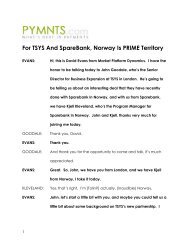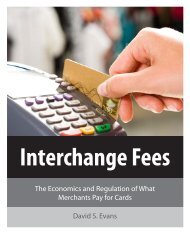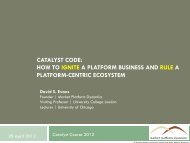Lydian Payments Journal - PYMNTS.com
Lydian Payments Journal - PYMNTS.com
Lydian Payments Journal - PYMNTS.com
You also want an ePaper? Increase the reach of your titles
YUMPU automatically turns print PDFs into web optimized ePapers that Google loves.
Figure 10: How APR Changes with Risk under Different Payment Scenarios<br />
Change (percentage points) in APR<br />
for a 100 point increase in credit score<br />
0.5<br />
0.0<br />
-0.5<br />
-1.0<br />
-1.5<br />
How APR Changes with Risk under Different<br />
Payment Scenarios<br />
0.32<br />
Lowest Rate First<br />
(LRF)<br />
-0.84<br />
Proportional<br />
Payment (PP)<br />
-1.07<br />
Equal Payment (EP)<br />
-1.27<br />
Highest Rate First<br />
(HRF)<br />
Note: Negative value indicates risk-based pricing.<br />
Considering penalty repricing, it was found that issuers typically did not notify consumers of the price<br />
change. (As mentioned previously, a related finding is that most borrowers did not know when they were<br />
at a penalty rate. 24 ) While legally permissible right now, this policy counters arguments that penalty<br />
repricing reduces moral hazard. Minimizing consumer knowledge certainly creates inefficiency, especially<br />
if it perpetuates moral hazard. 25<br />
Conclusion<br />
Credit cards have evolved from a product with one price to a product with several interest rates for<br />
different types of activity that can change for a number of reasons related to timing, index rates, triggering<br />
events, or simply the issuer’s choice. Credit cards also have a wide range of fees and add‐on products. Much<br />
of price <strong>com</strong>plexity in credit cards as a lending product is related to an attempt by firms to create<br />
misleading signals that cater to biases. This mix of prominent price signals in overweighted domains<br />
<strong>com</strong>bined with revenue enhancement mechanisms in underweighted domains describes an archetypical<br />
peacock market.<br />
Since this market structure is inherently inefficient, market intervention has been and continues to be<br />
appropriate. Attempts to deceive consumers and exploit biases should not be costless. Issuers need to fear<br />
some consequences for these actions other than that they will eventually be painlessly phased out. For<br />
24 Frank, “Priceless or Just Expensive?”<br />
25 If a borrower knew they were at a penalty rate and further knew that certain behavior (such as paying on time for<br />
six months) would cause their account to return to the regular rate, this would encourage responsible behavior.<br />
© 2009. Copying, reprinting, or distributing this article is forbidden by anyone other than the publisher or author. 39








